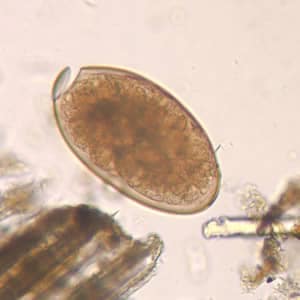Diagnosis

Fasciola hepatica egg in an unstained wet mount (400x magnification): F. hepatica eggs are broadly ellipsoidal, operculated, and measure 130–150 μm by 60–90 μm. (CDC Photo: DPDx)
The standard way to be sure a person is infected with Fasciola is by seeing the parasite. This is usually done by finding Fasciola eggs in stool (fecal) specimens examined under a microscope. More than one specimen may need to be examined to find the parasite. Sometimes eggs are found by examining duodenal contents or bile.
Infected people don’t start passing eggs until they have been infected for several months; people don’t pass eggs during the acute phase of the infection. Therefore, early on, the infection has to be diagnosed in other ways than by examining stool. Even during the chronic phase of infection, it can be difficult to find eggs in stool specimens from people who have light infections.
Certain types of blood tests can be helpful for diagnosing Fasciola infection, including routine blood work and tests that detect antibodies (an immune response) to the parasite.
More on: Resources for Health Professionals: Diagnosis
Related Link
For more information about laboratory diagnosis of Fasciola infection, see the DPDx web site: